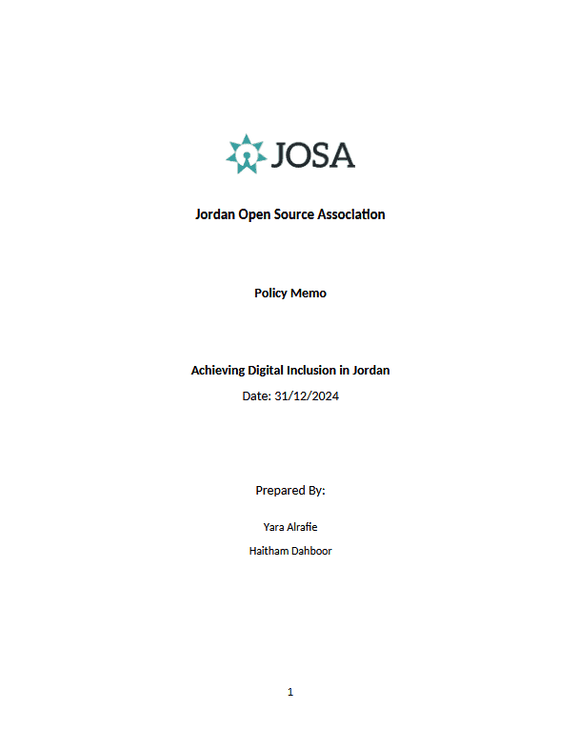Digital Inclusion Policy Memo
By Yara Alrafie and Haitham Dahboor
About This Policy Memo
This policy memo is specifically designed to provide feedback and concrete suggestions to the new
digital inclusion policy published recently by the Ministry of Digital Economy and Entrepreneurship. It
offers a comprehensive analysis of the challenges, policy options, and recommendations for achieving
digital inclusion across the country. By addressing structural barriers and proposing actionable
solutions, this memo aims to support policymakers in creating a more equitable and connected
society in Jordan.
Methodology
The methodology for this policy memo was developed through a multi-faceted approach. It began
with a thorough desk review of digital inclusion policies in various countries across the MENA region,
alongside international frameworks from the European Union and the United Nations. This
comparative analysis helped identify key trends, gaps, and best practices in digital inclusion efforts
globally. Additionally, JOSA organized a dedicated session at the Global Gathering 2024 Digital Rights
community, which convened experts from countries such as Tunisia, Argentina, The Gambia, Brazil,
and the United Kingdom. This session provided a broader global perspective, exposing the team to
diverse strategies and challenges related to digital inclusion. The insights and expert
recommendations from these international voices were integrated into the policy memo, ensuring it
reflects both regional priorities and global best practices tailored to Jordan's unique context.
In addition to the research and global consultations, JOSA engaged local entities and experts through
a targeted round-table discussion to further refine the methodology and gather additional
recommendations. This meeting involved 18 participants from a diverse range of stakeholders,
including government representatives, private sector, women’s rights organizations, and people with
disabilities organizations. By incorporating the insights and feedback of these local stakeholders, we
aimed to ensure the digital inclusion policy is comprehensive, contextually relevant, and responsive to
the needs of all segments of Jordanian society.
Executive Summary
The United Nations defines digital inclusion as, “equitable, meaningful, and safe access to use, lead,
and design of digital technologies, services, and associated opportunities for everyone, everywhere.”
As our daily lives become increasingly dependent on online connectivity, the importance of digital
inclusion has never been more crucial. Digital access is not just about connectivity; it supports
essential rights like freedom of thought and expression and enables access to healthcare, education, and economic opportunities. However, achieving true digital inclusion requires addressing structural
barriers, particularly for vulnerable groups, and ensuring equitable access across all demographics.
Jordan faces unique challenges in this area, including economic disparities, rural-urban divides, and
gender inequality. Despite ongoing efforts, such as poverty reduction strategies, self-employment
programs3, urban policy development4, and international collaborations5, the digital divide remains
pronounced, with rural communities, women, and economically disadvantaged groups particularly
affected. To bridge this gap, Jordan must prioritize inclusive digital policies, invest in infrastructure,
and design digital tools that meet the needs of all its citizens.
This policy memo provides concrete recommendations that will be used to support Jordan's digital
inclusion policy. Key suggestions include expanding the National Broadband Network, promoting
digital literacy, fostering public-private partnerships for affordable internet services, empowering
women through targeted digital initiatives, and investing in youth digital skills training. By
implementing these strategies, Jordan can foster a more equitable and connected society, driving
national development and social progress.
